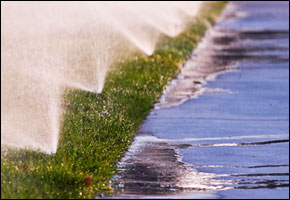New York’s Gas Rush Poses Environmental Threat
By Abrahm Lustgarten
ProPublica
On May 29 New York state’s top environmental officials assured state lawmakers that plans to drill for natural gas near the watershed that supplies New York City’s drinking water posed little danger.
A survey of other states had found “not one instance of drinking water contamination” from the water-intensive, horizontal drilling that would take place across New York’s southern tier, the officials told lawmakers in Albany.
Reassured, the legislature quickly approved a bill to speed up the permitting process for a huge influx of wells that could bring the state upwards of $1 billion in annual revenue. Gov. David Paterson has until Wednesday to decide whether he will sign the bill, and the state’s Department of Environmental Conservation, or DEC, says drilling permits could be approved in as little as 12 weeks.
But a joint investigation by ProPublica and New York City public radio station WNYC found that this type of drilling has caused significant environmental harm in other states and could affect the watershed that supplies New York City’s drinking water.
In New Mexico, oil and gas drilling that uses waste pits comparable to those planned for New York has already caused toxic chemicals to leach into the water table at some 800 sites. Colorado has reported more than 300 spills affecting its ground water.
DEC officials told ProPublica and WNYC they were not aware of those incidents, even though some of the information could have been found through a rudimentary Internet search. The officials couldn’t say for sure how New York would dispose of the millions of gallons of hazardous fluids that are byproducts of this type of drilling, and they learned only recently that the new drilling techniques would pump trace amounts of toxic chemicals into the ground. Four days after one interview, the DEC drafted a letter to the drilling companies, asking for detailed information about the type and amount of chemicals they will use.
With energy prices at record highs — natural gas prices are twice what they were in January — difficult-to-reach deposits of oil and gas in the United States are becoming commercially viable. At least nine companies have been locking up leases in New York, Pennsylvania and Appalachian states for drilling rights to the Marcellus Shale, a gas-rich rock layer that dives 7,000 to 9,000 feet beneath the earth’s surface. Some geologists predict it could meet the entire nation’s natural gas needs for more than two years.
But the extraction of natural resources from sensitive areas creates new problems for individual states, which bear the primary responsibility for protecting their environments. Some have created, or are in the process of creating, new regulations. Others, like New York, are just coming to grips with the potential impact of the drilling boom that may be headed their way.
New York’s existing laws have served it well for the most part. Since 1963 the state has permitted more than 13,000 gas wells with few problems.
“When we say we are going to protect the environment, you don’t have to trust us, you don’t have to believe us,” said Val Washington, deputy commissioner of remediation and materials management. “But look at our track record. I think it’s pretty good.”
However, the Marcellus development will be far more complicated than any previous drilling operations in the state. It will involve deeper, horizontal wells, possibly thousands of them. Each could suck up, and later spit out between 1 million and 5 million gallons of water — hundreds of times the amount used by a conventional well. That would place a significant burden on New York’s watersheds, including those that feed New York City’s reservoirs and farmland in Chemung, Tioga, Broome, Delaware and Sullivan Counties.
Some of the regional DEC offices that would oversee the Marcellus wells have no experience with gas drilling at all. Yet New York officials said they see little reason to update their generic 1992 environmental impact statement, which was drafted long before this form of drilling, called horizontal hydraulic fracturing or hydrofracking, was feasible on such a large scale.
“There is a little bit of learning curve…and that is where the concern falls,” said William Kappel, a hydrologist with the U.S. Geological Survey in Ithaca, N.Y. “The tremendous amounts of water used for these processes — where are you going to get it and what are you going to do with that?”
DEC officials could not answer those questions. They also acknowledge that they don’t track the process drillers use to dispose of “produced water,” as the gas and oil industry refers to its waste.
The DEC says the issue of drilling in the Marcellus has come on fast. “It wasn’t until last fall that we were really hit with the realization of what was happening,” said Washington. “We heard about the leases down on the southern frontier, and it’s been fairly recent, so we have our own work to do.”
Understanding the Geology
The gas in the Marcellus is held in tiny pockets, like bubbles in a brick of Swiss cheese. To extract it, a mixture of water, sand and chemicals is shot into the earth with such explosive force that it fractures the rock, releasing the bubbles to the surface. Along with the gas comes most of the water that was shot down the well. But by the time the water re-surfaces, it is also laden with natural toxics from the shale layer below — hydrocarbons, cancer-causing compounds including Benzene, Toluene, Xylene, and even radioactivity from uranium ore.
Waste water from the Marcellus formation may turn out to be slightly cleaner than that from other formations, early trials indicate, because it contains fewer of the naturally occurring toxins. But the U.S. Department of Energy lists produced water from gas drilling as among the most toxic of any oil industry byproduct, and when the water returns to the surface, it must be dealt with as toxic industrial waste. According to a 2004 report from Argonne National Laboratory prepared for the energy department, “Studies indicate that produced waters discharged from gas… platforms are about 10x more toxic than the produced waters discharged from oil platforms.”
In most states the tainted water produced by gas drilling is injected back into the ground in areas where solid rock layers keep it isolated from people or their drinking water. But the geology in New York and Pennsylvania is different, and the water will be discharged into an ecosystem where it might wind up coming out of New York City’s taps.
DEC’s current regulations require only that produced waste be treated before being discharged back into rivers. Agency officials said the water would be shipped to Pennsylvania and treated in specialized plants there. But an executive for three of the Pennsylvania plants told ProPublica and WNYC that New York officials hadn’t talked to him about the Marcellus wells. He said his plants don’t have the capacity to accept wastewater from New York.
“Don’t bet on it,” said Paul Hart, president of Hart Resource Technologies, which owns and operates three of the region’s five facilities, and whose phone number was given to ProPublica by New York DEC. Hart said his company can’t even build plants fast enough to handle Pennsylvania’s drilling expansion.
An executive with another plant said DEC had talked to him about taking some of the waste water, but he too had serious concerns about how New York will deal with a huge quantity of waste.
Treating the Water
The challenges New York faces in controlling drilling’s effect on its water are illustrated by what is happening at Tamarac Swamp, a state-protected ecological area.
The swamp sits on a quiet rural road brimming with oaks and maples, outside Oxford, N.Y., about a 45-minute drive from Binghamton. Last year, Oklahoma City-based Chesapeake Energy, the nation’s third largest gas producer, approached the sprawling wetland’s owners with an offer to lease drilling rights for $75 an acre, a bargain compared to today’s asking prices of $2,500.
The Zunno family declined Chesapeake’s offer, intending to preserve the wetland instead. But last month the family spotted a tanker truck from another drilling company. Its long septic hose was draped over the side of the public roadway, draining water from the Zunno’s culvert. Lori Zunno said a well had been built on a neighbor’s land and its operator had sent contractors in search of water for the drilling.
“We can’t even build within 100 feet of [the swamp] so I don’t understand why they can take septic trucks and pump it out,” Zunno said.
Zunno filed a complaint with the DEC, but she said no one seemed to know who was responsible for protecting her land, or what, if anything, the tanker company had done wrong. “They don’t even know their own rules — what’s regulated and what’s not,” she said. “There was such a lack of knowledge on their part about what could be done. There is no clear cut ‘you cannot take water from this spot.’'”
It turns out that the withdrawals from the Zunnos’ property should be regulated by the Susquehanna River Basin Commission. But Zunno didn’t know that. And neither did three DEC officials, who didn’t mention the Susquehanna commission before they declined to comment on the Zunnos’ complaint.
The Susquehanna commission and the neighboring Delaware River Basin Commission both require permits for regular or large water withdrawals, but New York does not regulate surface water extraction in other parts of the state. Anyone can take water from, say, the Hudson River, according to DEC’s regional captain for law enforcement in the Zunnos’ part of the state. When it comes to smaller water resources such as the Tamarac swamp, state law says only that wetlands cannot be drained.
Scientists and local land owners fear thousands of small water sources such as the Tamarac will be tapped to support the drilling industry, legally or illegally. The concern is that lots of small withdrawals will have a large impact.
“It’s not clear to me that there is any group who is looking at the overall impact of withdrawing the amount of water that might be required for the hydrofracking. Who is looking at the broader picture?” said Susan Riha, director of the New York State Water Resources Institute, a federally funded study group at Cornell University.
Riha is especially concerned about the limitations of the DEC’s Environmental Assessment Form, a crucial environmental impact document that drilling companies must file to get a permit. It doesn’t ask where drillers plan to get their water and only asks for a vague estimate of how much they plan to use.
“Looking at that short form, I was shocked,” Riha said. “It seems like we would have some procedures in place to put some pressure on the gas drilling operators to show that they are taking all possible steps to mitigate environmental impacts.”
DEC officials acknowledged the gaps. “You’re getting into the concept of cumulative impacts,” said James Tierney, assistant commission for the division of water. “One water withdrawal may not have an impact, but 50 would have a huge impact. We’re trying to figure it out.”
This issue alone, says Riha, is reason enough under the State Environmental Quality Review Act, which mandates impact evaluations, to order a supplement to the 1992 environmental impact statement the DEC is still using.
Scientists are also concerned about chemicals added to the water to prevent corrosion in the drill bits, lubricate the drilling and keep the drilling mud, as the mixture is called, at the right consistency to coax out gas.
As recently as last month, Bradley Field, the DEC’s director of the division of oil and minerals — the agency responsible for overseeing resource extraction in the state — appeared unaware of these additives. At a meeting with conservation advocates and state legislators he said drilling fluids contained nothing more than water and sand, according to Roger Downs, a conservation associate with the Sierra Club’s Atlantic Chapter.
DEC has since adjusted its stance.
“They add chemicals, we know they do that,” said Tierney, the water division official, in a meeting July 7. “We don’t know exactly what they are.”
In part that’s because the industry views its chemical recipes as trade secrets, akin to the formula for Coke or Pepsi, and federal laws exempt the oil and gas industry from disclosing those recipes to the public. For the most part, states have learned about the chemicals by analyzing waste pits and the contaminated ground water around them.
Tracking Down the Chemicals
In 2004 Theo Colborn, a respected scientist who specializes in the health effects of low-dose chemical exposure and opposes gas drilling, began investigating the makeup of drilling fluids. She was spurred by the story of a Colorado resident who suspected her cancer was tied to water contamination from a nearby gas well.
To figure out what was in the water, Colborn collected shipping manifests that trucks must carry when they haul hazardous materials for oil and gas servicing companies. When an accident occurred — a well spill in Colorado, or an explosion at a drilling site in Wyoming — she took water and soil samples and tested them for contaminants.
Colborn’s list eventually grew to nearly 200 chemicals, from suspected cancer-causing compounds like Benzene to a compound called 2-BE, which she told Congress causes adrenal tumors and other human health problems.
Her findings are supported by studies in New Mexico, Wyoming and Texas. Tests done by the New Mexico Office of Oil Conservation on mud and water from two gas drilling pits found Benzene, Toluene, Naphthalene and other substances.
In the Barnett Shale in Texas — the formation geologists consider most similar to the Marcellus Shale — the state has overseen the cleanup of radioactive material dredged up at hundreds of gas sites.
In Wyoming, where natural gas development has occurred on a large scale, the Environmental Protection Agency recently raised flags about one of the state’s biggest gas fields, the Pinedale anticline, where a large drinking water aquifer appears to have been contaminated. In a letter circulated to drillers there this summer, the EPA wrote that it found Benzene and other compounds in more than a third of groundwater samples tested. “Such impacts are environmentally unsatisfactory,” the letter said.
Val Washington, the New York DEC official, insisted New York can handle such problems.
“This is not New Mexico, this is not Colorado, this is New York,” said Washington. “Out of 13,000 wells that we have permitted, we have not, for example, had a single ground water problem with any of them.”
In conversations with ProPublica, DEC officials repeatedly downplayed the importance of the chemical additives. They make up just a tiny fraction of a percent of the fluids, Field said, because 99.4 percent is water and sand. But the remaining six-tenths of one percent of two million gallons of drilling water still equals 10,000 gallons of toxic chemicals — and that’s just for one well.
When pressed on whether New York would require the names of those chemicals as a prerequisite for approving an application in the Marcellus, Field said, “I don’t know. We’d have to take a look. I can’t say for sure right now.”
Asked why he might not require the names, he replied, “Because it would be a departure from how we typically do this. I haven’t really come to terms with that just yet.”
Hart, the Pennsylvania treatment plant executive, said the last time he talked with a DEC representative, the caller, whose name he couldn’t remember, displayed a general lack of understanding of water issues and didn’t have a clear grasp of waste water disposal alternatives.
“He did not understand the variations of the different chemicals and the potential for contamination,” Hart said. “Now with the Marcellus they are just completely unprepared for it. What I really think they are waiting for is the industry to make recommendations. I don’t think they are going to be proactive.”
DEC’s recent letter drafted to the gas industry asked for exhaustive data and information that closely adhered in both substance and actual language to questions posed by ProPublica and WNYC. It gave the companies four and a half weeks to comply with the request. But it did not make compliance a condition for drilling.
For now, DEC’s officials are asking their critics to have faith.
“If there is any doubt in anybody’s mind that we are going to proceed with these applications without full protection and consideration for the environment, they are just wrong,” Washington said. “It may be that the applicants down the line are going to have to wait a long time for their permits. There are some things to sort out here.”
Jonathan Sidhu and Allison Battey contributed to this report.
This report comes to Circle of Blue from ProPublica, an independent, non-profit newsroom based in Manhattan that produces investigative journalism in the public interest.

Circle of Blue provides relevant, reliable, and actionable on-the-ground information about the world’s resource crises.







Leave a Reply
Want to join the discussion?Feel free to contribute!